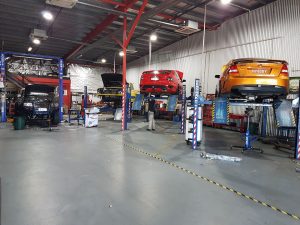
Taking care of your car’s engine is crucial for its longevity and performance. One often overlooked but essential aspect of engine maintenance is the timing belt. In this blog post, we will delve into the importance of timing belt replacement as a preventive maintenance task to ensure the health and reliability of your engine. See more
Understanding the Timing Belt
A timing belt is a vital component of an engine’s internal combustion system. It connects the camshaft(s) and crankshaft, ensuring that the valves open and close at the right time in sync with the piston movement. This synchronization is critical for the engine’s proper operation and optimal performance. Common types of timing belts include rubber belts with embedded fibers, such as neoprene or HSN, or newer materials like high-strength polymers. The timing belt system includes other components like tensioners and idler pulleys, which work together for efficient operation.
This timing belt is subject to wear and tear, and it can break without warning, causing damage to the engine. Therefore, it is essential to replace the timing belt as part of your car’s preventive maintenance schedule. The recommended replacement interval varies by manufacturer and model but typically ranges from 60,000 to 100,000 miles or every five to seven years.
How Does Timing Belt Work?
The timing belt works by synchronizing the motion of the camshaft(s) and crankshaft. As the pistons move up and down, the camshaft(s) rotate, opening and closing the engine’s valves. Without a properly functioning timing belt, the engine’s valves can open or close at the wrong time, leading to poor performance or even engine damage. The tensioners and idler pulleys are critical for ensuring that the timing belt remains taut and runs smoothly. Regular replacement of the timing belt and its associated components is essential for maintaining your engine’s health.
It should be noted that the timing belt should not be confused with the accessory belt, which drives other components such as the alternator and power steering pump. While the accessory belt may show signs of wear and tear, it does not have the same critical role in engine health as the timing belt. Be sure to consult your vehicle’s owner manual to determine when a timing belt replacement is recommended for your specific make and model. By scheduling this preventive maintenance, you can save yourself from costly repairs and ensure your engine runs smoothly for years to come.
Oil change is needed for the smooth functioning of your vehicle. It helps to keep the engine lubricated, which in turn enables all the parts to work together seamlessly without causing any damage. Ignoring the signs and not getting an oil change when needed can result in serious and expensive engine problems.
Therefore, it’s important to pay attention to the signs that your vehicle is giving you and schedule an oil change promptly. Don’t wait until it’s too late and you end up with a broken-down car on the side of the road. Keep track of your vehicle’s maintenance schedule and make sure to get an oil change as recommended by the manufacturer or your trusted mechanic.
Signs of a Worn or Damaged Timing Belt
A failing timing belt can have serious consequences for your engine. Signs of a worn or damaged timing belt may include engine misfires, rough idling, difficulty starting the engine, or a noticeable loss of power. In some cases, you may even hear strange noises coming from the engine compartment. Regular inspections are crucial to catch any signs of wear or damage early on and prevent catastrophic engine failure.
The damage caused by a broken timing belt can be extremely costly and time-consuming to repair. In addition to the cost of replacing the timing belt itself, there may be additional damage to the engine that requires extensive repairs. To avoid these potential issues, it’s important to follow your manufacturer’s recommended maintenance schedule for your timing belt. This typically involves replacing the timing belt every 60,000 to 100,000 miles, depending on the make and model of your vehicle.
Recommended Timing Belt Replacement Interval
Manufacturers provide specific recommendations for timing belt replacement intervals based on factors like mileage, age, and the type of engine. It is essential to consult your vehicle’s manual or contact the manufacturer to determine the recommended replacement interval. Ignoring or neglecting to replace the timing belt within the specified timeframe can lead to significant engine damage and costly repairs.
Replacing the timing belt is a crucial preventive maintenance task for maintaining engine health. The timing belt ensures that the camshaft and crankshaft operate in perfect synchronization, allowing the engine to function correctly. Over time, the timing belt can wear down and become damaged, leading to potential catastrophic engine failure.
DIY vs. Professional Replacement
Replacing a timing belt can be a complex and intricate task, requiring technical expertise and specialized tools. While some automotive enthusiasts may choose to replace the timing belt themselves, it is generally recommended to entrust this job to a professional mechanic. Professional replacement offers the advantage of experience, ensuring that the job is done correctly and minimizing the risk of errors or damage.
DIY replacement may save on labor costs, but if not done correctly, it can lead to costly repairs and potential engine damage. It is important to weigh the risks and benefits before deciding whether to tackle timing belt replacement on your own or seek the help of a professional mechanic.
Regardless of who performs the replacement, it is crucial to follow the manufacturer’s recommended replacement interval for the timing belt. Neglecting this preventive maintenance task can result in serious engine damage and costly repairs down the line. By staying ahead of schedule with timing belt replacements, you ensure optimal engine health and prolong the life of your vehicle.
Proper Disposal and Recycling of Used Oil
It’s important to dispose of used oil responsibly to minimize environmental impact. Improperly discarded oil can contaminate soil and water sources. Check your local regulations for oil disposal guidelines. Many communities have recycling centers or collection points where you can drop off used oil for proper recycling.
Recycling used oil has several benefits. It helps in conserving natural resources, reducing pollution and energy consumption. Recycled oil can be refined and used again, thus reducing the need for new oil production. Additionally, it is worth noting that re-refined oil actually performs better than newly refined oil as it contains fewer impurities.
One easy way to ensure proper disposal of your used oil is by taking your vehicle to a certified mechanic or oil change service provider. They have the necessary equipment and expertise to dispose of the used oil safely and efficiently.
Timing Belt Replacement Process
If you do decide to tackle the timing belt replacement yourself, it is crucial to follow a step-by-step guide specific to your vehicle’s make and model. The process involves removing various components to access the timing belt, carefully aligning the camshaft and crankshaft, and properly tensioning the belt. It is essential to use the right tools, follow safety precautions, and adhere to the manufacturer’s instructions to avoid costly mistakes.
The replacement process can take several hours and may require specialized tools, so it is important to set aside enough time and have all the necessary equipment on hand before beginning. While some vehicle manufacturers recommend replacing the timing belt every 60,000 miles, others suggest waiting until 100,000 or even 120,000 miles. However, it is important to note that the timing belt can fail unexpectedly, regardless of mileage. Therefore, it is always better to err on the side of caution and replace the timing belt sooner rather than later.
Cost of Timing Belt Replacement
The cost of timing belt replacement can vary depending on several factors, such as the make and model of your vehicle, the region you live in, and whether you choose a dealership or an independent mechanic. On average, timing belt replacement can range from a few hundred to a few thousand dollars. While this may seem like a significant expense, it is important to remember that preventive maintenance through timely belt replacement can save you from the much higher costs associated with engine repairs or replacements.
The cost of timing belt replacement may seem steep, but it is a necessary expense to ensure the health of your vehicle’s engine. As mentioned, the price can vary based on different factors, so it is crucial to do your research and compare prices from different sources. Choosing a reputable mechanic is also important as they will use quality parts and have experience in completing this type of maintenance. Ultimately, investing in preventive maintenance can save you a lot of money and headaches down the road.
Conclusion
Preventive maintenance is the key to maintaining a healthy and reliable engine. The timing belt plays a crucial role in the smooth operation of your engine, and regular replacement is essential to avoid costly repairs or engine failure. By following the manufacturer’s recommendations, considering professional assistance, and staying proactive with inspections, you can ensure your engine stays in optimal condition and enjoy the peace of mind that comes with a well-maintained vehicle. Schedule your timing belt replacement today and safeguard the heart of your car’s performance.
At DT Performance, we understand the importance of preventive maintenance in keeping your vehicle running smoothly. Our experienced technicians are equipped to handle all your timing belt replacement needs, and we use only top-quality parts to ensure the longevity of your engine. We also offer competitive pricing and transparent communication throughout the entire process, so you can have peace of mind knowing that you’re getting the best service at a fair price. Don’t wait until it’s too late – schedule your timing belt replacement with us today and take the first step towards a healthier engine.
See Other Related Post
Lottery Games at Rich Palm Casino
The director of Rich Palm Casino has a huge library of games that include a lot of different types thereof. Products are made by trustworthy

DT Performance is Here to Help – Services We Offer
DT Performance is Here to Help – Services We Offer Are you looking for a reliable and affordable data transmission solution? DT Performance has you
The Pokies Casino: A Paradigm of Online Gaming Excellence
In the ever-evolving world of online casinos, The Pokies Casino stands tall as a paradigm of gaming excellence, offering players a unique and exhilarating experience

What are the advantages of having anything repaired by a mechanic?
What are the advantages of having anything repaired by a mechanic? The advantages of having anything repaired by a mechanic are many. For one thing,

8 Car Maintenance Tips To Keep Your Car Running Like New
8 Car Maintenance Tips To Keep Your Car Running Like New No one wants to deal with car troubles, but they’re a fact of life.

How to keep your car in top condition?
How to keep your car in top condition? Maintaining your car is essential. You want to keep it in top condition to avoid any costly

Find a Mechanic Near Me: 10 Tips to Choosing the Right One
Find a Mechanic Near Me: 10 Tips to Choosing the Right One http://youtu.be/mL7Fvm9_Y2Q We all know how important it is to have a good Mechanic.




